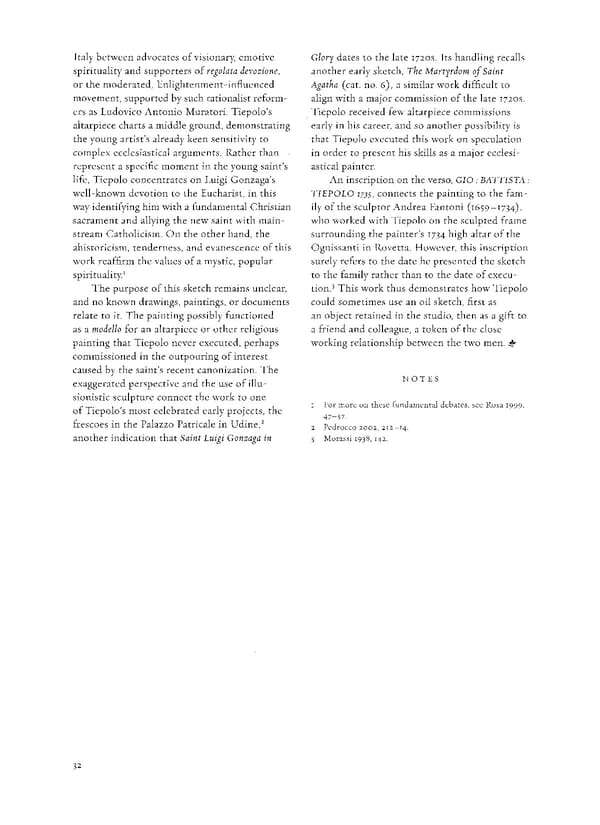Italy between advocates of visionary, emotive Glory dates to the late 17208. Its handling recalls spirituality and supporters of regolata devozione, another early sketch, The Martyrdom of Saint or the moderated, Enlightenment-influenced Agatha (cat. no. 6), a similar work difficult to movement, supported by such rationalist reform- align with a major commission of the late 17208. ers as Ludovico Antonio Muratori. Tiepolo's Tiepolo received few altarpiece commissions altarpiece charts a middle ground, demonstrating early in his career, and so another possibility is the young artist's already keen sensitivity to that Tiepolo executed this work on speculation complex ecclesiastical arguments. Rather than in order to present his skills as a major ecclesi- represent a specific moment in the young saint's astical painter. life, Tiepolo concentrates on Luigi Gonzaga's An inscription on the verso, GIO : BATTISTA ; well-known devotion to the Eucharist, in this TIEPOLO 1735, connects the painting to the fam- way identifying him with a fundamental Christian ily of the sculptor Andrea Fantoni (1659-1734), sacrament and allying the new saint with main- who worked with Tiepolo on the sculpted frame stream Catholicism. On the other hand, the surrounding the painter's 1734 high altar of the ahistoricism, tenderness, and evanescence of this Ognissanti in Rovetta. However, this inscription work reaffirm the values of a mystic, popular surely refers to the date he presented the sketch spirituality1 to the family rather than to the date of execu- The purpose of this sketch remains unclear, tion.3 This work thus demonstrates how Tiepolo and no known drawings, paintings, or documents could sometimes use an oil sketch, first as relate to it. The painting possibly functioned an object retained in the studio, then as a gift to as a modello for an altarpiece or other religious a friend and colleague, a token of the close painting that Tiepolo never executed, perhaps working relationship between the two men. & commissioned in the outpouring of interest caused by the saint's recent canonization. The exaggerated perspective and the use of illu- NOTES sionistic sculpture connect the work to one of Tiepolo's most celebrated early projects, the 1 For more on these fundamental debates, see Rosa 1999, frescoes in the Palazzo Patricale in Udine,2 47-57- 2 Pedrocco 2002, 212-14. another indication that Saint Luigi Gonzaga in 3 Morassi 1938, 142. 32
 Giambattista Tiepolo: Fifteen Oil Sketches Page 32 Page 34
Giambattista Tiepolo: Fifteen Oil Sketches Page 32 Page 34